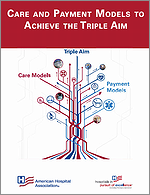Care and Payment Models to Achieve the Triple Aim
Hospitals and health care systems are striving to achieve the Triple Aim – improving the patient experience of care (including quality and safety), improving the health of populations, and reducing the per capita cost of health care. To achieve these goals, hospital leaders are designing new care delivery systems.
 Adoption of these new systems can be facilitated by new and innovative payment models that center on individual and community needs, rewarding high-quality with desired individual and population health outcomes.
Adoption of these new systems can be facilitated by new and innovative payment models that center on individual and community needs, rewarding high-quality with desired individual and population health outcomes.
Two AHA committees, the 2015 Committee on Research and 2015 Committee on Performance Improvement, released a joint report, “Care and Payment Models to Achieve the Triple Aim,” which addresses how hospitals can develop new delivery systems and innovative payment models that best meet the needs of their organizations and communities. Redesigning care delivery requires hospitals and health care systems to disrupt their conventional thinking and reimagine care from the patient’s perspective. New care delivery systems will have to be woven into the fabric of local communities and the lives of patients and families.
The 2015 AHA Committee on Performance Improvement studied design and redesign of a new care delivery system and identified seven key principles:
- Design the care delivery system with the whole person at the center.
- Empower people and the care delivery system itself with information, technology and transparency to promote health.
- Build care management and coordination systems.
- Integrate behavioral health and social determinants of health with physical health.
- Develop collaborative leadership.
- Integrate care delivery into the community.
- Create safe and highly reliable care organizations.
The 2015 AHA Committee on Research examined payment models that have emerged as the health care field transforms to a value-based care system. All of these models derive from service-based, bundled-based or population-based payment approaches. Critical to any model are risk adjustments and incentives to drive care quality and efficiency. To assist hospital and health care systems in moving toward new payments models, the Committee on Research outlined short-term and long-term policy recommendations, targeting stress points that can impede the movement from volume-based to value-based care.
Developing health care delivery and payment models to achieve the Triple Aim will be challenging. Critical to success is that hospital and health care system leaders select clinical and payment models that work best for their organizations and communities. “Care and Payment Models to Achieve the Triple Aim” provides foundational strategies, recommendations and resources as hospital and health care systems move forward in the changing environment.

